Orton Gillingham Vowel Intensive Drill: Examples & More
Posted by Brainspring on 19th Mar 2019
Welcome to the next post in our series, Orton-Gillingham Lesson Plan Basics! Our last ‘topic’ was on the Three-Part-Drill, the most recent article covering The Blending Drill. If you missed it, click HERE! Today’s article covers The Vowel Intensive activity, which is a further review of previously taught skills. For the vowel intensive activity, we start by reviewing short vowels if needed, then work towards mastering any other challenging sounds or skills.
Today’s article covers The Vowel Intensive activity, which is a further review of previously taught skills. For the vowel intensive activity, we start by reviewing short vowels if needed, then work towards mastering any other challenging sounds or skills.
What is the Purpose of the Vowel Intensive Activity?
The intensive activity part of the lesson is a set-aside time for further review of problematic sounds or skills. You know your students best. Target your activity to make the most of your time and your students' time.
If they are stuck on short vowels, review short vowels. We want to make sure these basic and frequently used vowel sounds are strong and automatic. However, if your students are strong in short vowel recognition, move on to higher-level material that you notice needs attention.
Why is the Vowel Intensive Activity So Important?
The vowel intensive activity plays a big part in literacy by reinforcing important skills and addressing areas where students may struggle. For many learners, particularly those with reading difficulties or dyslexia, vowels can be challenging because they often have multiple sounds and rely heavily on context for correct pronunciation. The vowel intensive activity provides targeted practice, helping students master these tricky parts of the English language.
By focusing on vowel sounds and their usage in a structured way, this activity strengthens phonemic awareness. Students learn to isolate, recognize, and manipulate vowel sounds, which are essential for both decoding and encoding skills.
Regular practice through the vowel intensive activity ensures that students internalize these patterns, making them automatic and easy to recall during reading and writing tasks. This activity is not only a review tool but also a way to build confidence in learners, giving them the skills they need to succeed in literacy.
What Does the Vowel Intensive Activity Look Like?
There are a multitude of ways we can review problematic material. Regardless of the activity, we aim to keep it short and sweet. Some teachers like to complete the intensive activity right after the Three-Part-Drill. The drill is a review and the intensive is also a review.
You may find that you already have your small group right in front of you after the Three-Part-Drill. Perfect time to do a brief 2-5 minute intensive and then move along with your day!
Unsure of where to begin? Start with these:
Example 1:
“My first graders often miscue the short vowels a and u. I notice their miscues during reading and spelling.”
An engaging and fun activity would be something short and sweet, such as a vowel stick intensive. Ideally, each student would have a set of five popsicle sticks, each with a vowel and picture on it (a=apple, etc.). In this example, students would only need the vowel sticks a and u because these have been identified as problematic for this group.
The teacher then would call out a single vowel sound (“a”) and the students would hold up the correct vowel stick. If this is too easy, you can up the ante by adding a consonant to the end, thus making a vowel consonant string of letters (“at”).
In this case, the teacher would say “at” and the students would listen for the initial sound, holding up the vowel stick that corresponds to the vowel sound they heard. The students would then say the vowel sound they heard (“a”).
To make an even more challenging intensive activity for short vowels, provide students with a CVC word containing both targeted vowel sounds (“mud” “Chad”). Students listen for the medial sound in the CVC words the teacher calls out. Students then hold up the vowel stick that represents the heard vowel sound, and lastly, say the vowel sound out loud (“u” or “a”).
Example 2:
“After teaching the spelling rule for -dge, my students are still unsure of which spelling of the /j/ sound to use.”
In this case, the teacher has identified that j vs. -dge is a problematic skill. This is more than likely slowing down the students significantly in their spelling, and therefore can use some fine-tuning. Review the j vs -dge spelling rule with the class/student. List the steps of the rule for them to see, to help them internalize this process.
-dge spelling rule: we use -dge if we hear the /j/ sound at the end of a one-syllable word preceded by a short vowel.
Then, introduce the “passing judgment on -dge” activity and ask students to pretend they are judges at court. Their pencil can be their pretend gavel. As you call out words containing the /j/ sound, students have to listen and identify if the word is “guilty of -dge.”
Do not provide students the written word until they have identified if the word contains the spelling of j or -dge. (Some example words – journey, jump, judge, bridge, pledge, etc.)
Example 3:
“My 6th graders mix up their number root words over and over again. Help!”
Using a categorizing intensive activity can help clear this up, especially when practiced a couple/few times throughout the week(s). Ask students to write the following number root words on a piece of paper.
uni/mono
bi/di/du/duo
tri
quad/quar/tetra
pent/quint
Then, call out a number (in the above example 1-5). Students will place a tally mark in the corresponding root word section.
After students tally, ask which root word corresponds to the number (this makes it more multisensory – the more they say it and hear it, the stronger the recall will become).
As you can see, the vowel intensive slot on an Orton-Gillingham lesson plan can really be used to give the student intensive practice on any skill or skills that they may be weak in.
We hope you enjoy these vowel intensive ideas. For more ideas, visit our Pinterest page by clicking HERE!
Written by Brainspring






